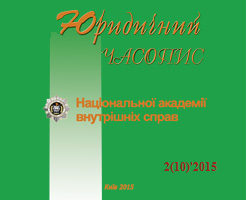Prison Libraries in Ukrainian Soviet Socialist Republic in 1919
Keywords:
library, library activity, librarian, book, printed source, cultural and educational building activities
Abstract
The activity of prison libraries in USSR in 1919 was illustrated in terms of the archival documents analysis; and this issue was illustrated in the normative, legal and practical aspects. The article gives new important facts about the question explored. The history of Ukrainian penitentiary system is underexplored in many aspects. In particular, the activity of prison libraries also is one these aspects. Everybody knows that the social correction labor is one of the means of the resocialization and re-education of offenders. These regulations are consolidated in the Criminal Code of Ukraine (part 3, article 6). Libraries are one of the most important parts of the social correctional labor. According with the Criminal Code of Ukraine (part 3, article 6) an offender may possess not more 10 items of books, the number of books and magazines is not limited. According to the world’s standards and tendenties, the prison administrations will be able to review this number upwards. In developed democratic countries the prisoners in the penitentiary agencies have an opportunity to take any books from the exchange collection. The status of library activity (the amount of books in the fund; the topical variety of books; the number of offenders using the books; the amount of books used) is one of the main reported factors of social-correctional labour in the penitentiary agencies. The development of offender’s self-consciousness is practically impossible without reading literature. That’s why, the observation of historical retrospectives of this problem is important nowadays. The observation of the background with different scientific movements attached together (in particular history, archival science, criminalexecutive law, penitentiary system development) is always interesting and useful in terms of practical and theoretical points of view. After examining the library activity in prisons in USSR, we can come to the following conclusions: 1) The Bolsheviks’ campaign against illiteracy of population reasonably assisted in development of library activity in places of preliminary detention and in the places of deprivation of freedom. The Bolsheviks launched this campaign with a view to ideological working-up of population, right after the rise to power; 2) During 1919 cultural educational subdivisions of Central Correctional Division of People’s Commissariat of Justice in USSR accepted at least 6 normative-legal documents, which concerned the organization of library activity in prisons; in particular the Circular № 91, on 18.07.1919 which accepted the first part of «Librarian instructions (concerning the organization of book catalogues)»; 3) The average book cost was at the limit 6–10 karbovanets; 4) The monthly salary of prisoner’s librarian was at the limit of 525–1000 Karbovanets; 5) The biggest book stock was in Chernigov, Kharkov and Kyiv.Downloads
Download data is not yet available.
Abstract views: 79 PDF Downloads: 41
How to Cite
[1]
Isakov, P. 1. Prison Libraries in Ukrainian Soviet Socialist Republic in 1919. Law Magazine of the National Academy of Internal Affairs. 10, 2 (1), 146-157.
Issue
Section
Theoretical and historical aspects of legal science
Copyright (c) 2017 Law Magazine of the National Academy of Internal Affairs

This work is licensed under a Creative Commons Attribution-NonCommercial-NoDerivatives 4.0 International License.
- Authors reserve the right to authorship of their own work and transfer to the magazine the right of the first publication of this work under the terms of the Creative Commons Attribution License, which allows other persons to freely distribute published work with mandatory reference to authors of the original work and the first publication of an article in this magazine.
- Authors have the right to enter into separate additional agreements on non-exclusive dissemination of the work in the form in which it was published in the journal (for example, to post an article in the institution's repository or to publish as part of a monograph), provided that the link to the first publication of the work in this journal is maintained.
- The journal's policy allows and encourages the posting of articles by authors on the Internet (for example, in electronic storehouses of institutions or on personal websites), both before the submission of this manuscript to the editorial office and during its editorial processing, as this contributes to the creation of a productive scientific discussion and positively affects the efficiency and dynamics of citing the published work.




